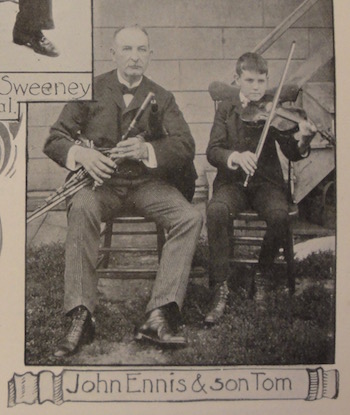Annotation:Reel of Bogie (1) (The): Difference between revisions
No edit summary |
No edit summary |
||
| Line 41: | Line 41: | ||
<p><font face="Century Gothic" size="3"> '''Additional notes''' </font></p> | <p><font face="Century Gothic" size="3"> '''Additional notes''' </font></p> | ||
<p><font face="Century Gothic" size="3"> | <p><font face="Century Gothic" size="3"> | ||
[[File: | [[File:johnennis2.jpg|550px|thumb|right|John Ennis and son Tom, c. 1902]] | ||
<font color=red>''Source for notated version''</font>: - Chicago police patrolman, piper and flute player [[biography:John Ennis]], originally from County Kildare [O’Neill]. | <font color=red>''Source for notated version''</font>: - Chicago police patrolman, piper and flute player [[biography:John Ennis]], originally from County Kildare [O’Neill]. | ||
<br> | <br> | ||
Revision as of 06:29, 8 February 2020
REEL OF BOGIE [1], THE ("Seisd Bogac" or "Cor an Bogaig"). AKA and see "Cuffe Street," "Cuffstreet Lasses (The)," “Highlander's Kneebuckle (3) (The),” "Holly Bush (The)," "Long Chase (The)," "Maun's Fancy," "Mulcahy's," “New Year's Night,” “Style of Ballylanders,” "Tramps (The)," Irish, English; Reel. England, Northumberland. E Dorian (Mulvihill, O’Neill): A Dorian (Howe). Standard tuning (fiddle). AB. As "Real o' Bogee," it is one of the "missing tunes" from William Vickers' 1770 Northumbrian dance tune manuscript. Brian Conway plays a Sligo setting of the reel. In liner notes to his album, says the tune is sometimes known as “The Tramps,” and was recorded in New York by Paddy Killoran and by Michael Coleman, both originally from County Sligo. Coleman called it “Maun's Fancy” on an unreleased side from his last recording session in 1944. “Mountain Rose,” “New Year’s Night," "Castlebar Traveller (The),” "Gossan that Beat His Father (The)," "Laurel Bush (The)," "Showman's Reel (The)," "Spence's Reel (1)," "Tuehey's Reel," "West Gale (The)," "Yeoman's Reel" are related, primarily in the first strain. See also the first strain of Scottish variants in the "Lochiel's Rant" tune family.
The name "Reel of Bogie" is attached to Scottish tunes and songs dating to the 18th century. The most famous Scottish instance of the name is in the last line in each stanza of a song attributed to the Alexander, 4th Duke of Gordon (strathspey king William Marshall's employer). Poet Robert Burns wrote that he was "charmed" by the Duke's song, which he believed was one of the few 'modern' songs to contain "true Scottish memory." The first two stanzas of the song (known as "Cauld Kail in Aberdeen") go:
There's cauld kail in Aberdeen,
And castocks in Stra'bogie;
Gin I but hae a bonny lass,
Ye're welcome to your coggie:
And ye may sit up a' the night,
And drink till it be braid day-light;
Give me a lass baith clean and tight,
To dance the Reel of Bogie.
In cotillons the French excel;
John Bull loves contra-dances:
The Spaniards dance fandangos well;
Mynheer an allemande prances:
In foursome reels the Scotch delight,
The threesome maist dance wond'rous light;
But twasome ding a' out o' sight,
Danc'd to the Reel of Bogie.
See "Reel of Bogie (2) (The)" for the Scottish tune.

